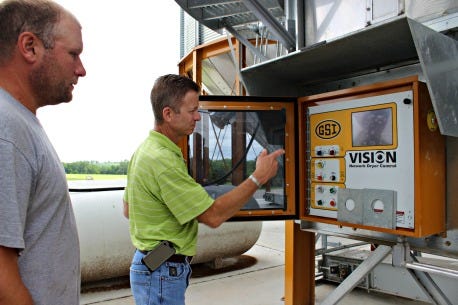
Trafton Shannon can remember the days back in 1997 when he would harvest the grain from his farm with just one six-row combine. Today, he uses two eight-row combines with two times the bushel capacity hauling up to four times as many bushels.
"A lot has changed in farming since I first started," he says. "Larger machinery allows us to cover more ground faster." The row crop and cattle farmer from Saline County had to find somewhere to go with all that grain in a short amount of time.
Like many farmers his grain handling system could not keep up. "I needed something that I could access when I needed it and where I needed it."

GREATER CAPACITY: The GSI grain handling system provides 175,000 bushels of storage.
So, Shannon, who farms with his dad Wayne and brother Bert, decided to expand the family's grain handling facility with a system that provided speed, greater harvest flexibility and reduced grain loss.
He worked with W.B. Young Company out of Marshall, a locally owned grain handling and storage equipment dealer that has been in business for 55 years. The company provides engineering, construction and custom steel fabrication for the agriculture industry. Together, they designed a facility that works for Shannon's row crop operation.
Increasing receiving rate
When it comes to handling grain at the receiving site it is all about speed. Randy Sleeper, general manager for W.B. Young, says the new system allows for trucks to get into the site and out quickly.
Trucks will drive on to the concrete pad equipped with a metal grate. Underneath are two pits that can hold 800 bushels each. Located 13-feet below ground, the 142-foot bucket elevator transports the grain to the grain hopper tank, or wet hopper bin. The 18-foot bin holds up to 20,000 bushels.

CONSTANT CONTROL: W.B. Young general manager Randy Sleeper demonstrates how Saline County farmer Trafton Shannon can use the GSI Vision dryer control to keep track of grain moisture from a touchscreen computer.
Sleeper says, sensors in the wet hopper bin serve as a safety device that shuts off flow to the unit as it approaches full. A receiving leg from the wet bin delivers the grain to the GSI 20100 Tower Dryer.
Drying down efficiently
Like many Missouri farmers, Shannon likes for the corn to dry somewhat in the field. But last year that was not the case. In the west central portion of the state, Shannon says "the corn crop just never dried down." Last season, he dried nearly 80% of his crop.
The GSI Tower Dryer system is more efficient than older conventional models. The modular dryer can operate in the minimal cooling position delivering dried and cooled grain within 10 degrees F of ambient temperature. Shannon can monitor the dryer through the GSI Vision dryer control which is a 10.4-inch touch screen monitor located in an electrical panel on the side of the dryer unit.
A 100-hsp motor allows the dryer to handle 2,000 bushels per hour. Last fall, Shannon says there were days that the dryer was handling 30,000 bushels. And he can keep track of the progress right from his own phone.
Using his smartphone, Shannon is able to monitor the dryer operation with GSI's WatchDog System, which monitors various dryer functions, such as moisture, temperature and dryer status, all from the convenience of a home or office computer, as well as a smartphone. It sends texts or emails to Shannon's smartphone on the dryer's progress.
"I don't have to go out in the middle of the night to transfer from one storage bin to another," he explains. The (leveling) sensors know when one storage bin is full and shuts down, Sleeper explains. "It will then switch to the other bin and start filling again."
It also offers the farmer a little piece of mind. "When I go to bed, I set (my phone) next to me and I can see what is going on down the road," Shannon says. "And when I am on the road or in the field, I can monitor the grain system and shut it down if necessary."
Storing for shipment
Once dry, the grain is then routed to two 48-foot GSI grain bins capable of holding up to 75,000 bushels each. Shannon will store the grain waiting for ideal times to market. And when that time comes, it is once again about efficiency.
"We have a double load out which is nice to help trucks get in and out," Shannon says. He chose a hopper tank with a 5,488 bushel capacity.
The additional grain storage capacity at this location brings Shannon's on-farm storage to 400,000 bushels. He also has grain storage facilities in other areas of the county.
"I like being able to load and unload grain when I want and where I want," Shannon adds. He is already looking toward future additions to the facility including wet bin storage.
About the Author(s)
You May Also Like






